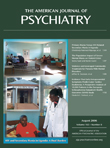The Population Impact of Severe Mental Illness on Violent Crime
Abstract
Objective: This study aimed to determine the population impact of patients with severe mental illness on violent crime. Method: Sweden possesses high-quality national registers for all hospital admissions and criminal convictions. All individuals discharged from the hospital with ICD diagnoses of schizophrenia and other psychoses (N=98,082) were linked to the crime register to determine the population-attributable risk of patients with severe mental illness to violent crime. The attributable risk was calculated by gender, three age bands (15–24, 25–39, and 40 years and over), and offense type. Results: Over a 13-year period, there were 45 violent crimes committed per 1,000 inhabitants. Of these, 2.4 were attributable to patients with severe mental illness. This corresponds to a population-attributable risk fraction of 5.2%. This attributable risk fraction was higher in women than men across all age bands. In women ages 25–39, it was 14.0%, and in women over 40, it was 19.0%. The attributable risk fractions were lowest in those ages 15–24 (2.3% for male patients and 2.9% for female patients). Conclusions: The population impact of patients with severe mental illness on violent crime, estimated by calculating the population-attributable risk, varies by gender and age. Overall, the population-attributable risk fraction of patients was 5%, suggesting that patients with severe mental illness commit one in 20 violent crimes.



